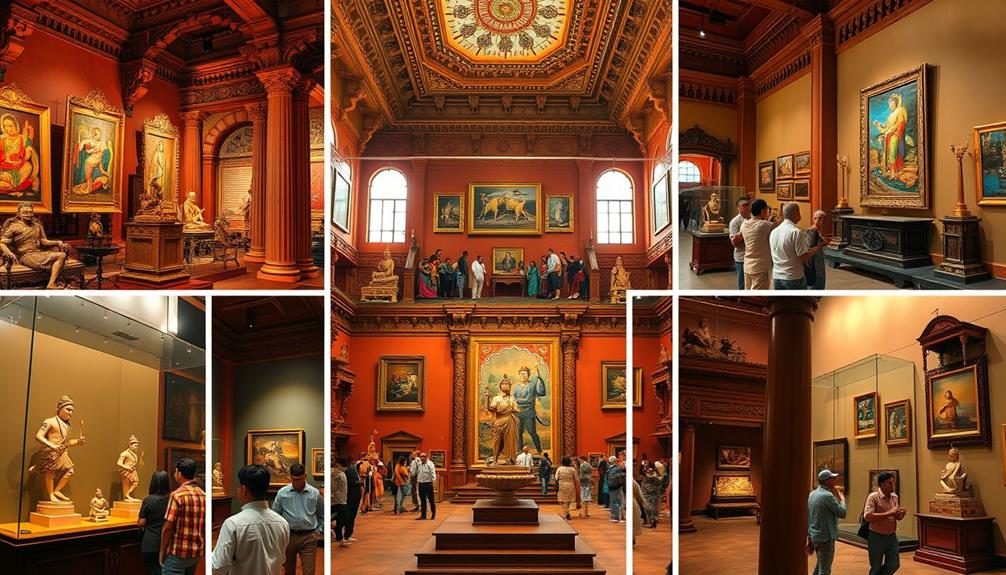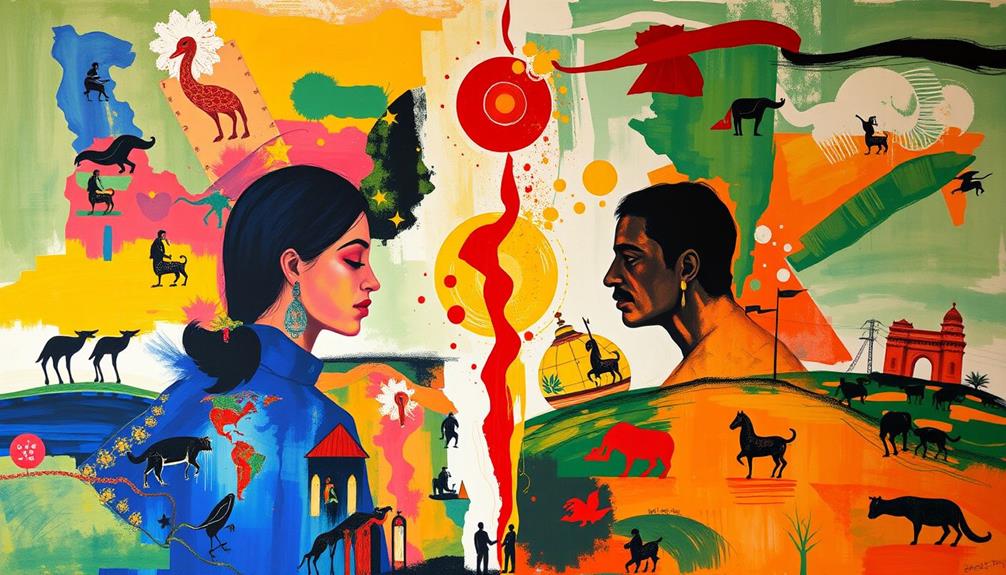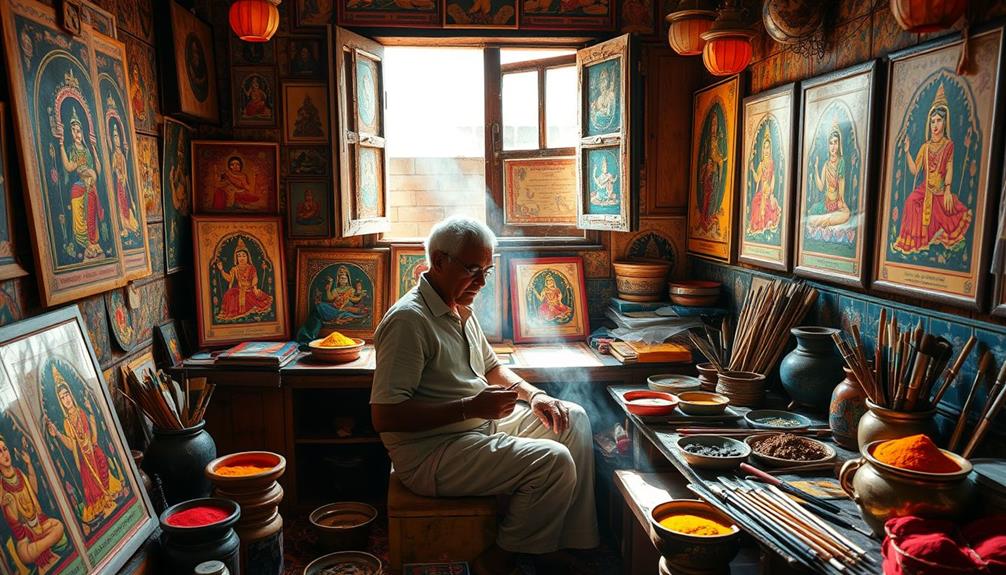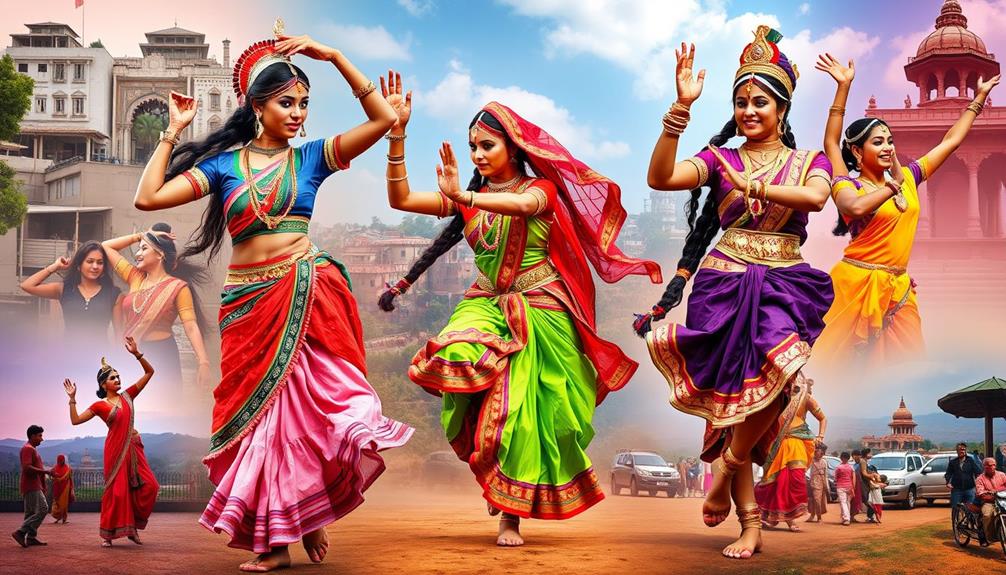When you explore Kolkata's museums, you're stepping into a vibrant world of art that showcases the city's rich cultural heritage. Each museum offers unique collections, like the Indian Museum's extensive artifacts and the Ashutosh Museum's focus on Eastern and North Indian art. Don't miss the contemporary works at the Artsacre Museum, either. You'll also find fascinating exhibitions at Currency Building and antique curios at Konark Collectables. These venues not only celebrate history but also enhance your understanding of modern creativity. There's so much to uncover here that you'll want to stick around for more insights into this artistic journey.
Key Takeaways
- Kolkata's Indian Museum houses thousands of artifacts, showcasing a vast array of art, archaeology, and anthropology since its establishment in 1814.
- The Ashutosh Museum of Indian Art focuses on Eastern and North Indian art, featuring notable paintings, textiles, and sculptures that reflect cultural narratives.
- Artsacre Museum of Bengal Modern Art offers a serene atmosphere to appreciate contemporary works by prominent artists like Anjali Ela Menon and Jamini Roy.
- Currency Building – Ghare Baire presents engaging exhibitions that narrate Bengal's art history, enhanced by highly-rated audio guides for a deeper understanding.
- Konark Collectables features a variety of antique curios, including terracotta, ceramic, and bronze items, enriching the experience for art and antique enthusiasts.
Overview of Kolkata's Art Scene
Kolkata boasts a vibrant art scene that reflects its rich cultural heritage and modern creativity. As you explore the city, you'll discover a plethora of art and culture that intertwines history with contemporary expression. The integration of AI and Music Creation into artistic practices is also gaining traction, inspiring artists to experiment with innovative techniques.
From the striking pieces at the Artsacre Museum of Bengal Modern Art, showcasing celebrated artists like Anjali Ela Menon and Jamini Roy, to the extensive collections at the Ashutosh Museum of Indian Art, each venue tells a unique story of Bengal's artistic evolution.
You'll find that the historical Currency Building – Ghare Baire offers fascinating insights into the region's art history, complete with engaging audio guides that enhance your understanding. The Indian Museum, established in 1814, stands as the oldest museum in India, featuring thousands of artifacts that span various artistic disciplines, including painting, textiles, and decorative arts.
Moreover, events like the week-long art festival hosted by DAG invite you to immerse yourself in Kolkata's creative spirit, celebrating both traditional and modern art forms. This city truly embodies a dynamic fusion of art and culture, making it an essential destination for anyone enthusiastic to appreciate the depth of its artistic landscape.
Key Museums and Their Offerings
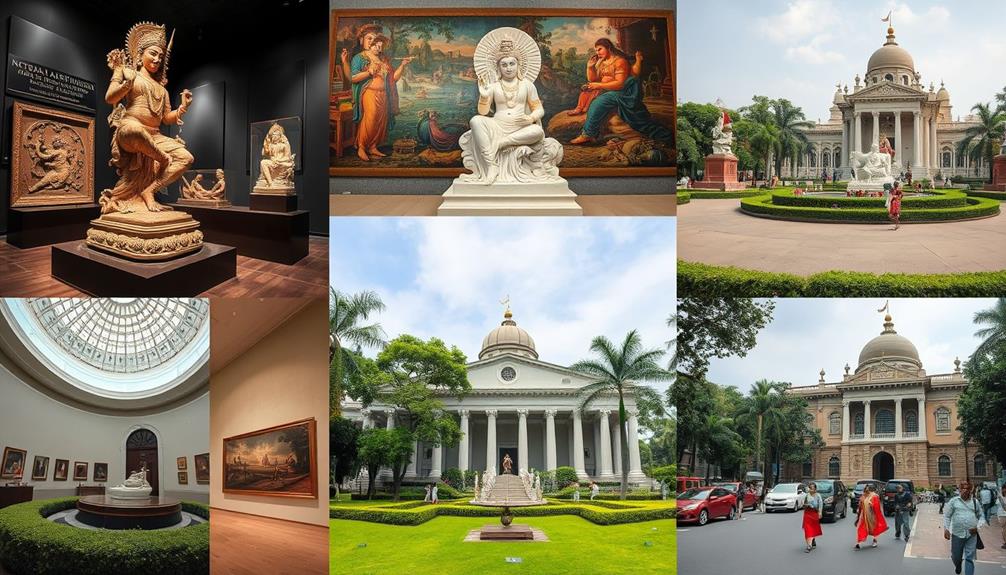
When you explore Kolkata's key museums, you'll discover a rich tapestry of diverse art collections that reflect the city's cultural significance.
These institutions often intertwine creativity with historical context, much like the mesmerizing exploration of art and culture seen in artistic journeys.
Each museum offers a unique perspective, showcasing everything from ancient artifacts to modern masterpieces.
You'll see how these collections not only celebrate artistic talent but also impact the cultural landscape of the region.
Diverse Art Collections
Exploring the diverse art collections in Kolkata's museums reveals a treasure trove of cultural heritage and creativity.
The Ashutosh Museum of Indian Art stands out with its extensive collections of paintings, textiles, and sculptures, focusing on Eastern and North Indian art. Additionally, engaging with digital creativity can enhance the experience of understanding these artworks, particularly for families looking to integrate technology into their learning.
If you're a South Asian art enthusiast, this art museum is a must-visit.
For modern art lovers, the Artsacre Museum of Bengal Modern Art features works by renowned artists like Anjali Ela Menon and Jamini Roy.
You'll find a serene atmosphere perfect for appreciating Bengal's contemporary art scene.
Antique collectors will enjoy Konark Collectables, which offers an array of antique curios, including terracotta and ceramic cutlery, as well as brass and bronze utensils.
The Currency Building – Ghare Baire creatively narrates Bengal's art history through engaging exhibitions and audio guides.
Cultural Significance and Impact
The art collections in Kolkata's museums not only showcase creativity but also reflect the city's rich cultural significance and impact on the region's heritage. Each museum plays a significant role in preserving and promoting various aspects of Indian art, making them essential stops for anyone interested in the vibrant history of the area.
These institutions serve as a repository of artistic expression, where visitors can explore emerging home decor trends that influence contemporary art styles.
Here are some key museums and their offerings:
- Indian Museum: Established in 1814, it's the oldest museum in India, featuring thousands of artifacts across art, archaeology, and anthropology.
- Ashutosh Museum of Indian Art: Home to an extensive collection of Eastern and North Indian art, it serves as an important resource for history and art enthusiasts.
- Artsacre Museum of Bengal Modern Art: Showcasing iconic works from artists like Anjali Ela Menon and Jamini Roy, it offers a serene space for experiencing modern Bengal art.
- Currency Building – Ghare Baire: This museum highlights Bengal's art history through engaging exhibitions, making the region's cultural significance accessible to all.
These museums collectively contribute to the understanding and appreciation of art, enriching Kolkata's cultural landscape.
Historical Significance of Indian Art
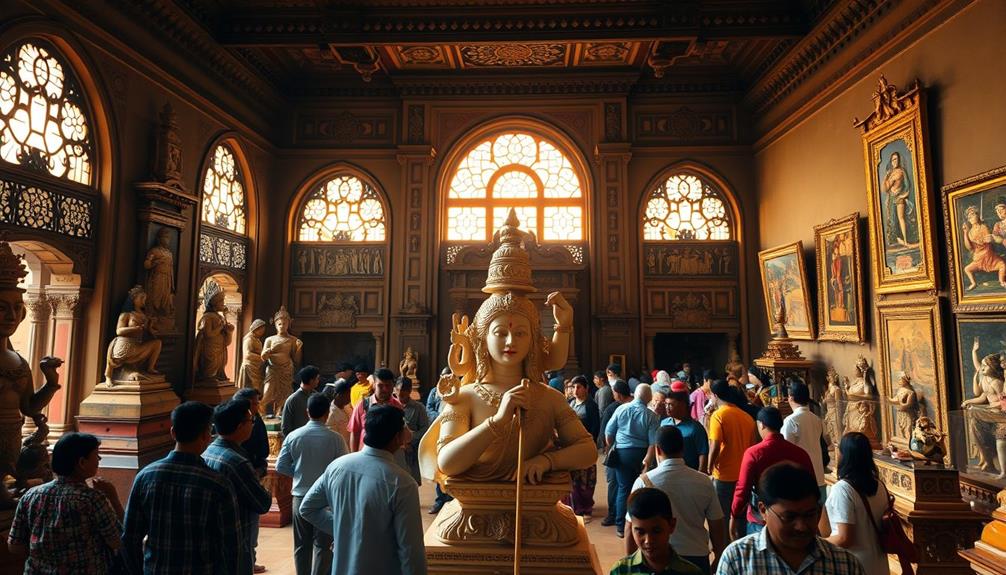
When you explore the historical significance of Indian art, you'll notice how artistic styles have evolved across different periods, reflecting cultural narratives and regional variations.
This evolution isn't only a demonstration of the artistry of the time but also serves as a medium for philosophical expression, inviting deeper reflection on thought-provoking articles regarding the human experience.
Each era, from the Mughal influence to the emergence of the Bengal School, offers a unique lens into India's rich heritage.
Evolution of Artistic Styles
Indian art has undergone a remarkable transformation over the centuries, reflecting the rich tapestry of its history and cultural influences. The evolution of artistic styles showcases how various periods and dynamics shaped the art you see today, much like the complexities involved in the divorce process overview.
At the Indian Museum in Kolkata, you can witness this journey through different artistic expressions.
Here are four key milestones in the evolution of Indian art:
- Mughal Era (1526-1857): This period introduced naturalism, merging Persian aesthetics with local styles, creating a unique artistic language.
- Bengal School of Art (Late 19th Century): Artists aimed to revive traditional themes, reasserting cultural narratives through modern techniques, which influenced many.
- Indian Miniature Painting: Diverse regional styles emerged, featuring distinct themes like Buddhist narratives in the East and vibrant Jain motifs in the West.
- Company Paintings (19th Century): These works blended Indian themes with Western techniques, mirroring the socio-political changes during colonial times.
Each of these movements has contributed to the rich heritage you explore at the Indian Museum, reflecting the evolving identity of Indian art.
Influence of Cultural Narratives
Art serves as a mirror reflecting the cultural narratives that shape societies, and Indian art is no exception. When you explore the collections of Kolkata museums, you'll witness how historical importance is intricately woven into the fabric of Indian art.
Ancient Indian art thrived in royal courts and temples, with unique styles emerging in the Eastern and Western regions, each telling a story of its time. This rich tapestry of artistic expression can be further understood through insights into astrological insights, which reveal underlying personality traits that may influence artistic creation.
During the Mughal era, starting in 1526, a rich cultural patronage blossomed, merging Persian influences with local traditions. This period notably shaped Northern Indian artistic legacies.
You'll also find the Bengal School of Art, which emerged in the late 19th century, emphasizing Indian literature and mythology.
As you explore deeper, notice how Indian Miniature and Mughal paintings often depict themes of court life and religious narratives, reflecting the socio-political dynamics of their eras.
Additionally, styles like Rajput and Pahari paintings highlight local culture, showcasing the region's unique narratives throughout history.
Significance of Regional Variations
Regional variations in Indian art reveal a rich tapestry of cultural identities and historical narratives that resonate throughout the subcontinent. When you explore the vast collections in Kolkata's museums, you'll notice how each region articulates its unique story through art.
These regional styles have evolved markedly, particularly during pivotal historical periods, reflecting local influences and traditions. Additionally, considering the potential for long-term growth through precious metals, art collectors often view their collections as a form of investment, akin to a diversification of retirement portfolio.
Here are four key aspects of these regional variations:
- Mughal Influence: The intricate detail in Mughal paintings showcases a blend of Persian and Indian artistry, highlighting a notable cultural synthesis.
- Bengal School of Art: Emerging in the late 19th century, this movement emphasized local themes, shaping a national identity amid colonial pressures.
- Miniature Painting Diversity: Eastern Indian schools focus on Buddhist themes, while Western Indian manuscripts depict Jain subjects, illustrating varied artistic approaches.
- Contemporary Impact: The legacy of styles like Pahari and Deccan continues to inspire today's artists, reminding us of the importance of preserving these rich heritages.
Visiting museums in Kolkata gives you a chance to appreciate these compelling narratives and their ongoing importance in Indian art.
Diverse Art Styles and Techniques
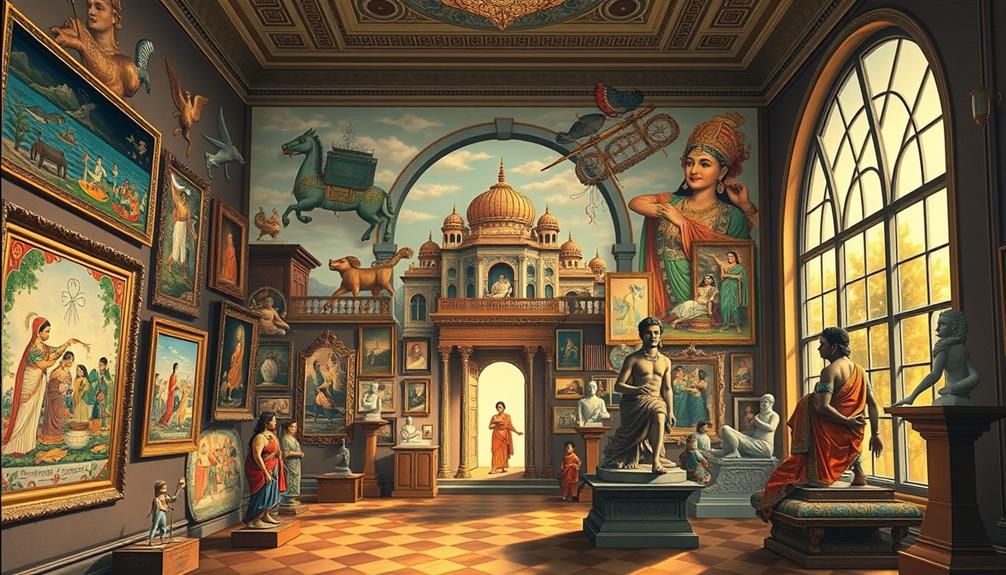
Within Kolkata's museums, you'll discover a rich tapestry of diverse art styles and techniques that reflect the region's cultural heritage. The Ashutosh Museum of Indian Art, located on the ground floor, showcases an extensive collection of Eastern and North Indian art, featuring an array of painting, textile, and sculpture techniques that appeal to enthusiasts of South Asian history.
As you explore these collections, consider how traditional practices have evolved over time, similar to the way herbalism has developed through various cultures and eras.
You can investigate Indian Miniature Painting, where various regional styles emerge, including Mughal paintings known for their naturalism and vibrant colors, alongside Rajasthani works that merge Mughal influences with local narratives.
Don't miss the Bengal School of Art, which arose in the late 19th century, modernizing Indian art by weaving in cultural stories and traditional themes, greatly influencing contemporary expressions.
Additionally, Deccani paintings offer a fascinating fusion of Vijaynagar and Persian traditions, while Pahari paintings from areas like Kangra and Basholi reflect local culture through miniature styles and religious themes.
The Currency Building – Ghare Baire enriches your visit with engaging audio guides, enhancing your understanding of the diverse artistic techniques displayed throughout Kolkata's art history.
Notable Artists Shaping Kolkata's Art
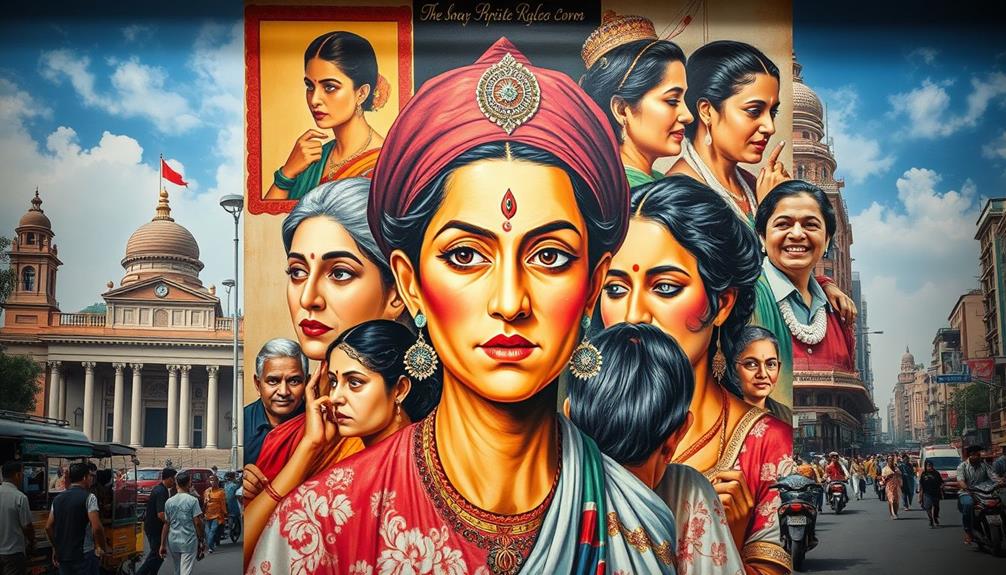
Kolkata's art scene owes much to influential artists from the Bengal School, like Abanindranath Tagore, who brought cultural narratives to the forefront.
The region's rich history is also reflected in its artistic expressions, reminiscent of the significance seen in Aboriginal practices.
You can't overlook the contributions of Mughal-era artists, such as Ustad Mansur, who enriched the naturalism in Indian painting.
Together, these figures shaped a vibrant artistic landscape that continues to inspire today.
Influential Bengal School Artists
The vibrant world of the Bengal School has profoundly shaped the art scene in Kolkata, showcasing influential artists whose works continue to resonate today.
These artists not only redefined aesthetics but also celebrated Indian culture through their innovative approaches.
Here are four key figures from the Bengal School:
- Abanindranath Tagore – Celebrated for his miniatures of Radha and Krishna, he redefined Indian art by incorporating cultural narratives that resonate deeply with audiences.
- Jamini Roy – Known for his modern interpretations of traditional themes, he skillfully used vibrant colors and folk motifs to highlight Indian heritage, making art accessible to the masses.
- E.B. Havell – Instrumental in establishing the Bengal School, he advocated reviving Indian art by emphasizing indigenous styles over Western influences, paving the way for future generations.
- Gaganendranath Tagore – A significant contributor who blended mythological themes with innovative techniques, his work greatly influenced the evolution of modern Indian art.
The Bengal School's legacy continues to inspire contemporary artists, bridging traditional practices with modern expressions while reflecting the region's rich cultural heritage.
Mughal Era Contributions
Mughal artistry has left an indelible mark on Kolkata's cultural landscape, shaping how art is perceived and created today. As an art lover, you'll appreciate how the Mughal era, beginning in 1526, cultivated a rich artistic legacy in India.
Remarkable figures like Ustad Mansur emerged during this time, celebrated for his stunning naturalistic depictions of flora and fauna. Under Emperor Jahangir, the emphasis on individual representation in portrait albums shifted the artistic direction, showcasing the importance of personality and detail.
The Mughal painting style evolved considerably, merging Persian influences with European techniques, especially evident in the vibrant court paintings of Akbar, which celebrated diverse cultural themes.
However, as the Mughal Empire declined, regional styles began to flourish, particularly the Bengal School of Art. This movement drew inspiration from Mughal traditions while promoting Indian narratives, with artists like Abanindranath Tagore leading the way.
Today, the intricate details and vibrant colors of remarkable Mughal artworks continue to inspire contemporary artists in Kolkata, creating a unique dialogue between historical and modern artistic expressions.
As you explore, you'll see how this rich heritage resonates through the city's vibrant art scene.
Cultural Themes in Artworks
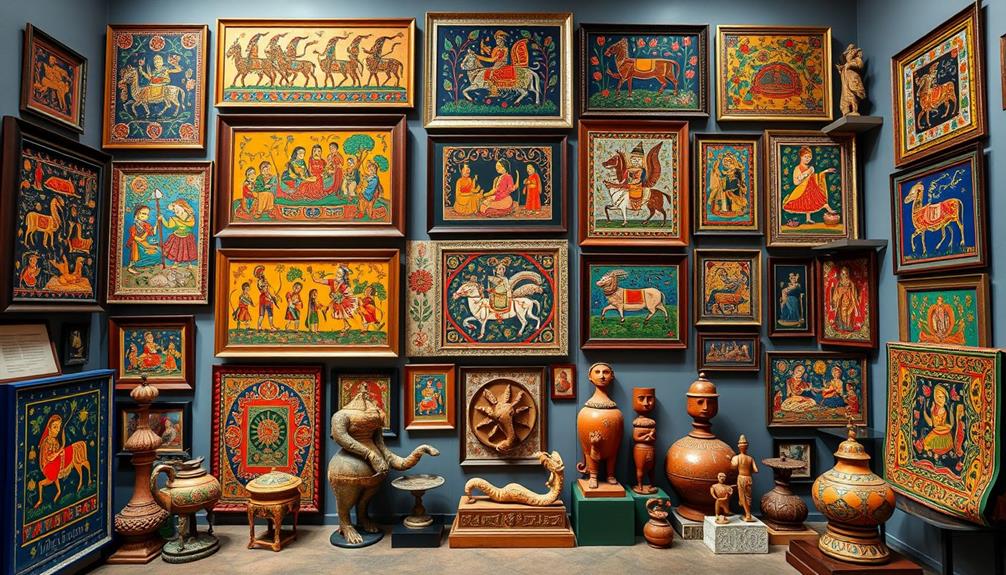
Art collections across Kolkata's museums vividly showcase the rich tapestry of cultural themes that define the region's artistic landscape.
As you explore these museums of art, you'll notice how they reflect significant cultural narratives, from historical to contemporary expressions. Here are some key themes you might encounter:
- Spirituality: The Indian Museum's collections highlight themes of spirituality through ancient sculptures and Buddhist relics, capturing the essence of India's spiritual heritage.
- Identity: At the Artsacre Museum of Bengal Modern Art, artists like Anjali Ela Menon and Jamini Roy investigate modern Bengal art, exploring personal and cultural identity.
- Socio-Political Dynamics: The Currency Building – Ghare Baire showcases thematic exhibitions that engage with Bengal's socio-political history, enriching your understanding of the region's past.
- Tradition vs. Modernity: The Harrington Street Arts Centre blends modern and traditional artworks, reflecting contemporary cultural themes while making art accessible to all.
As you wander through these collections, you'll gain deeper insights into how these cultural themes intertwine, enriching your experience of Kolkata's vibrant artistic scene.
Impact of Museums on Society
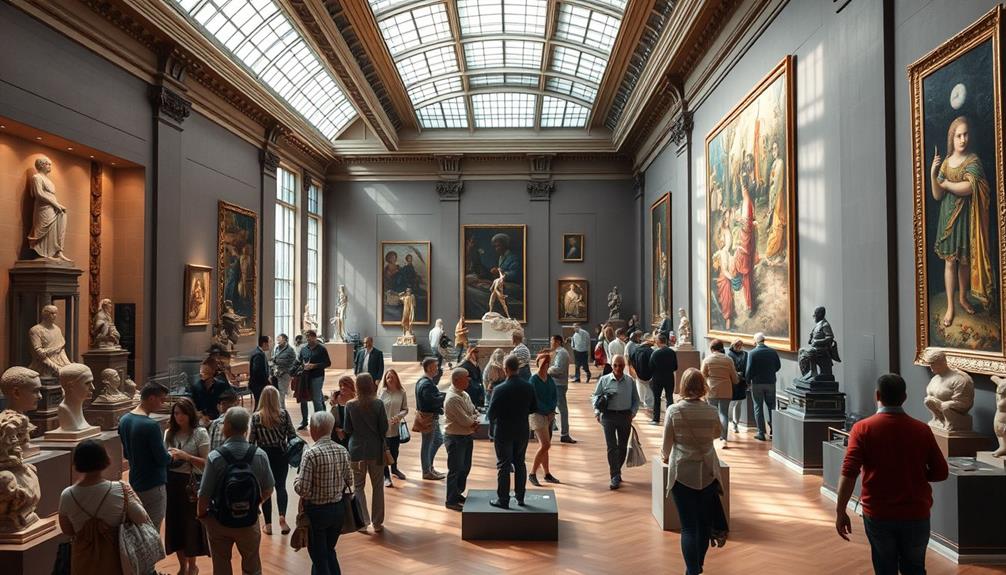
Kolkata's museums play an essential role in shaping societal values and fostering community connections. They serve as cultural bridges, promoting engagement and enhancing your appreciation of local heritage.
For instance, the Indian Museum, established in 1814, is one of the largest in India. Its extensive collections, displayed across multiple floors, including the first floor, deepen your understanding of national heritage and history.
Events like the "City as a Museum" festival actively involve you in art discussions and activities, helping you connect with your cultural legacy.
You'll find that the Artsacre Museum of Bengal Modern Art provides a serene viewing experience, encouraging reflection on modern Bengal art and attracting art enthusiasts. Furthermore, the Currency Building – Ghare Baire offers unique insights into Bengal's art history. Engaging audio guides and dynamic exhibitions keep cultural narratives alive and enhance your experience.
Through these interactions, you not only learn about art but also participate in a broader cultural dialogue.
Museums in Kolkata are crucial spaces where collective memory and local identity thrive, making them essential to the fabric of society.
Special Exhibitions and Events
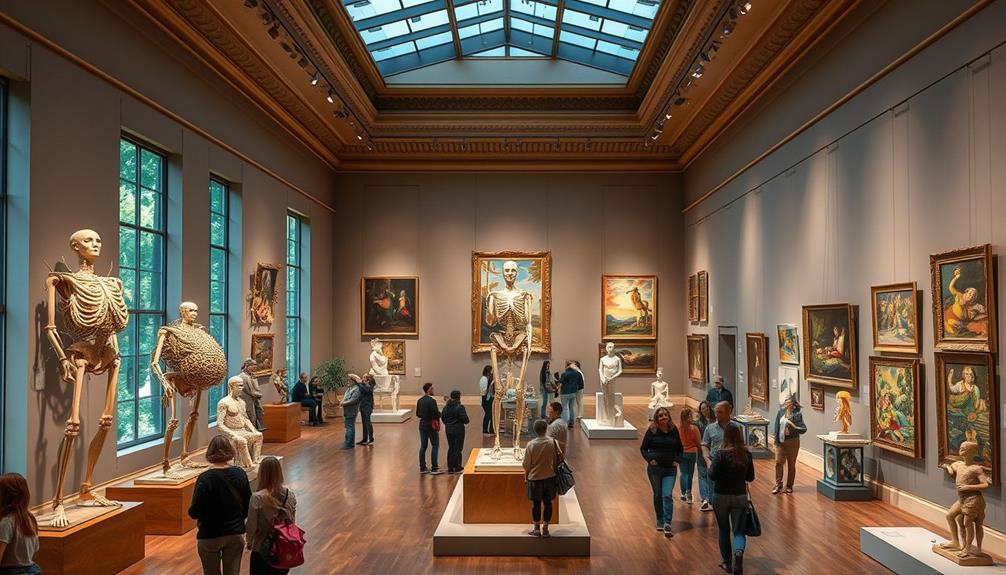
Throughout the year, numerous special exhibitions and events bring Kolkata's vibrant art scene to life. One standout event is the City as a Museum festival, hosted by DAG from November 17-26, 2023. This festival showcases the city's artistic heritage and invites local communities to engage in enriching art discussions.
Here are some highlights you shouldn't miss:
- Special Viewings: Collaborate with the Victoria Memorial for exclusive viewings of history paintings, providing educational opportunities for teachers and students.
- Workshops: Participate in hands-on workshops on traditional fresco painting techniques at the Hooghly Imambara, where you can learn about local art practices.
- Musical Performances: Enjoy musical performances by leading local artists that enhance the cultural experience throughout the festival.
- Community Focus: Discover and appreciate the contributions of lesser-known artists, emphasizing the importance of community involvement in celebrating Kolkata's art history.
You'll also find connections to iconic artists like Nandalal Bose, whose legacy continues to inspire contemporary creatives.
These events not only celebrate the past but also foster a vibrant dialogue about the future of Kolkata's art scene.
Visitor Experience and Accessibility
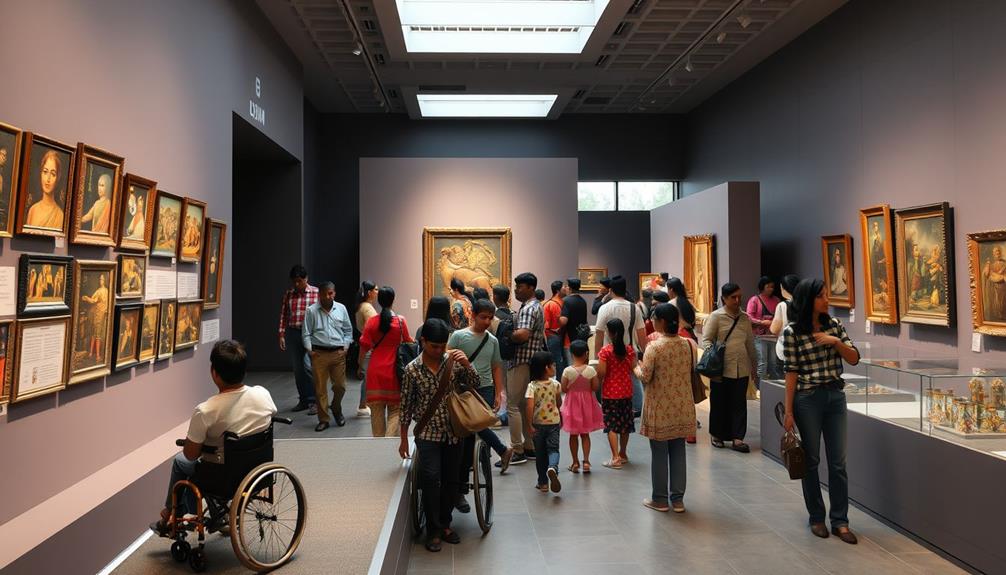
How can you make the most of your visit to Kolkata's museums? First, plan your trip wisely. Most museums, like the Indian Museum and Ashutosh Museum of Indian Art, operate daily from 10 a.m. to 5 p.m., but remember they're closed on Mondays and holidays. This guarantees you won't miss out on the art collections.
For an exceptional visitor experience, try the Currency Building – Ghare Baire. Its engaging audio guides and fresh exhibitions have earned it a perfect rating of 5.0 bubbles.
If you prefer a quieter atmosphere, the Artsacre Museum of Bengal Modern Art is ideal, offering a serene environment with fewer visitors, perfect for appreciating modern Bengal art without the crowds.
Don't overlook the Harrington Street Arts Centre, which features an affordable entry fee, making art accessibly enjoyable for everyone.
As you explore, keep an eye on KMOMA, currently under construction, which promises to enhance visitor engagement with its focus on modern and contemporary art.
Future of Art in Kolkata
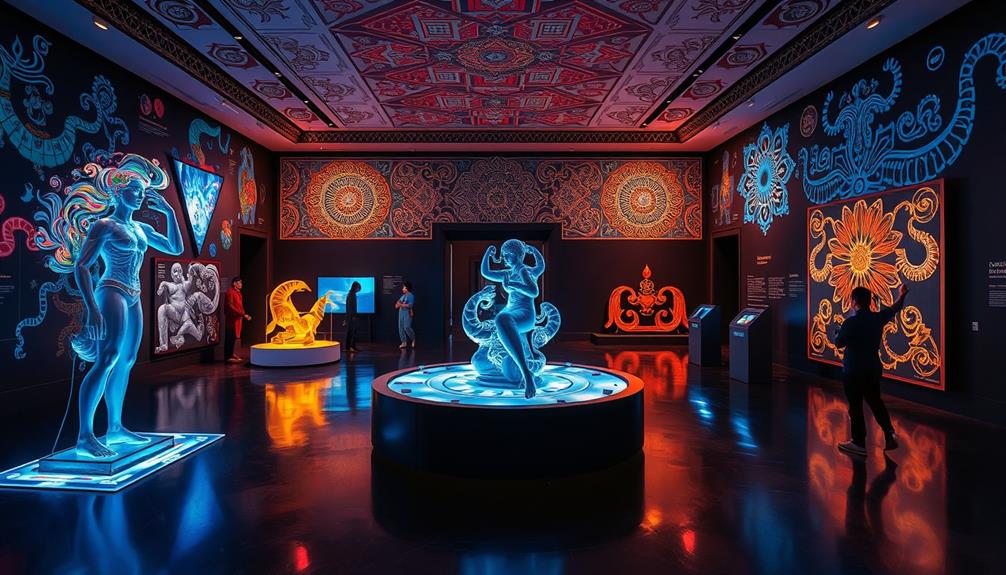
With a vibrant future on the horizon, Kolkata's art scene is poised for significant transformation. The upcoming week-long art festival by DAG from November 17-26, 2023, will celebrate the city's rich artistic heritage and engage local communities in meaningful discussions.
This festival, along with the development of KMOMA, is set to redefine the future of art in Kolkata, particularly in contemporary times.
Here are four key aspects to watch for:
- World-Class Museum: KMOMA will focus on modern and contemporary art, merging Eastern and Western architectural styles to create an immersive experience.
- Community Engagement: Collaborations with local artists and institutions like Victoria Memorial will enhance community involvement, ensuring art remains accessible to everyone.
- Democratizing Art: Initiatives aim to create dialogues that bridge the gap between traditional and modern art, allowing diverse voices to be heard.
- Cultural Festivals: Events like the DAG festival will foster a vibrant art culture, encouraging public participation and appreciation.
As you explore the future of art in Kolkata, expect an exciting blend of tradition and innovation that will inspire generations to come.
Frequently Asked Questions
What Are the Main Collections of the Museum?
You'll find diverse collections at the museum, including art, archaeology, anthropology, geology, zoology, and botany. Each section showcases thousands of artifacts, providing an extensive glimpse into various aspects of history and culture.
Which Institution in Kolkata Has the Greatest Collection of Indian Artifacts?
If you're seeking a treasure trove of Indian artifacts, the Indian Museum in Kolkata's your best bet. Its vast collection spans centuries, showcasing the rich tapestry of India's art, culture, and history like a vibrant mosaic.
What Is the History of Kolkata Museum?
You'll find that Kolkata's museum history stretches back to 1814, when the Asiatic Society established the Indian Museum. It opened to the public in 1878, showcasing diverse artifacts across various galleries and promoting cultural engagement.
How Much Is the Ticket for Indian Museum 2024?
Getting in's like finding a hidden gem! In 2024, entry fees for Indian citizens at the Indian Museum will likely stay low, around INR 20-30, while foreign tourists might pay around INR 500.
Conclusion
Kolkata's art scene is a vibrant tapestry woven with history, innovation, and creativity that's nothing short of a cultural explosion. As you explore its museums, you'll uncover masterpieces that tell stories of the past while inspiring future generations. These institutions do more than display art; they foster a community where creativity thrives. So, whether you're a seasoned art lover or a curious newcomer, immerse yourself in Kolkata's rich artistic heritage and let it ignite your imagination!
